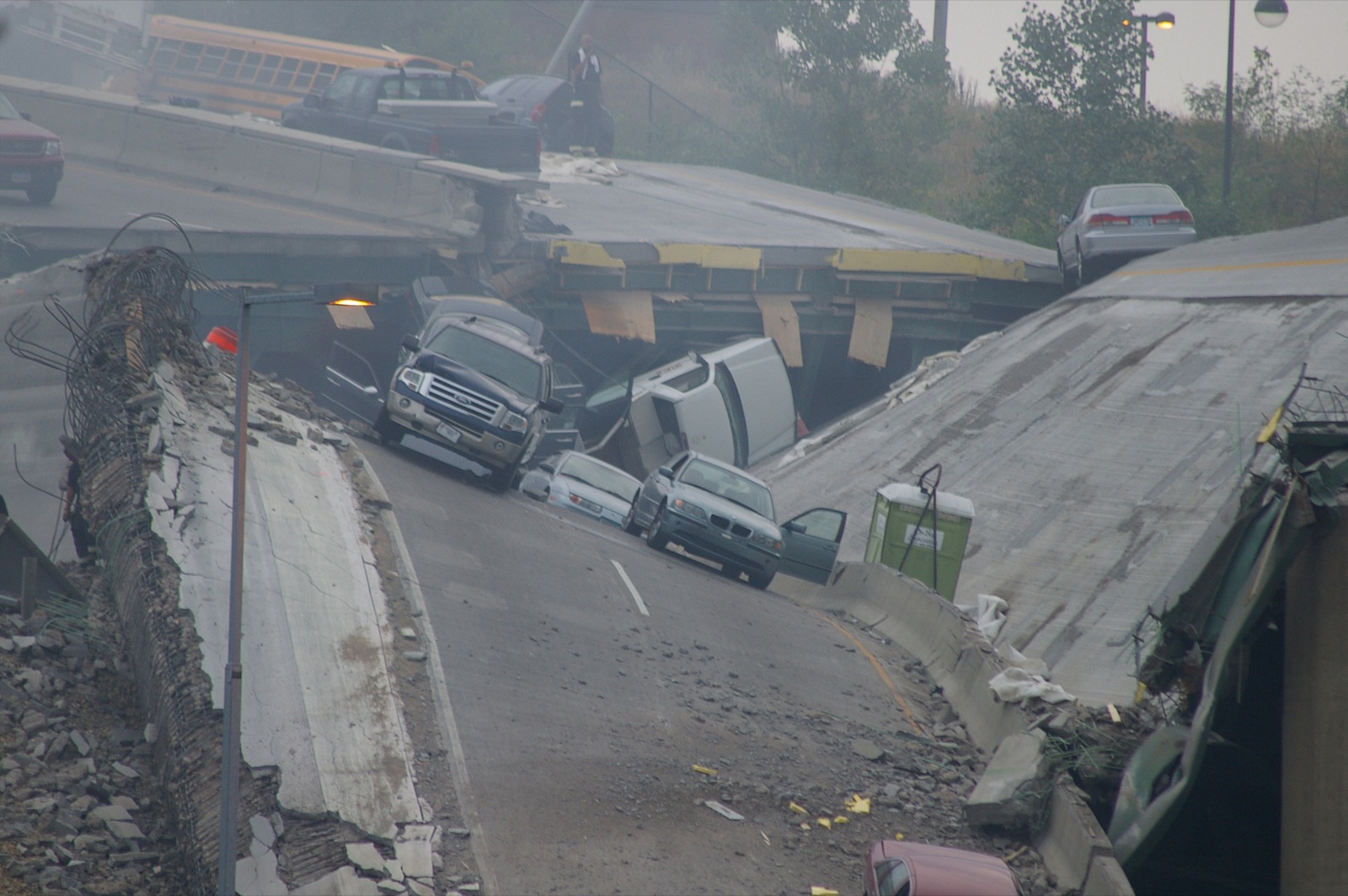Art & Soul post #30 by guest author Lisa Carnegis-–
I was in my living room when my attention was pulled to the TV by news broadcasters announcing the I-35W bridge had collapsed over the Mississippi River. The TV screamed, “One hundred forty-five people injured, thirteen dead due to a catastrophic bridge design failure!” I walked closer to the screen, stunned. Twenty-four hours prior, I had driven over that bridge at least six times because my travel softball team had had a tournament in Minneapolis that weekend. Up to that point, I had never considered the risk of driving over a bridge. It was 2007, I was thirteen years old, and my eyes were opened to a reality that still affects me today…everything has a risk, even if seemingly sturdy, and we spend our days realizing how vulnerable we are and how precious it is to be alive.
Avoidance
After you experience a traumatic, near-death event, or even an event as small as a cat scratch, your brain registers all the information surrounding that moment, memorizing and studying even the smallest details to protect you should the circumstances ever arise again. In my example of the I-35W bridge collapse, even if I had heard that Jesus had returned in Minneapolis, I’d be looking for an alternate route to get to Him!
We avoid the things that hurt or betray us because pain teaches us that they aren’t trustworthy. How often have you heard someone say, “I hate cats,” and, after you inquire about their hatred, they respond, “One scratched me when I was little.” Moments before they were scratched, I bet they were smiling and enthralled by the fluffy, soft, cute animal. They may have even played with cats several times before, but, after one cat employed its claws, hatred and a lifetime of avoidance of cats followed.
While there is sound wisdom in avoiding dangerous people, places, or things, the saddest result of trauma is that it can mar things that are good and beautiful and meant for enjoyment. Even though the brain is trying to protect and keep you alive with its strong black and white thinking, it can cause you to avoid what had once brought you life, joy, and peace. Unfortunately, it’s common for people to sacrifice once-loved things for their safety and live a lifetime looking for “alternate routes” to avoid more pain and panic.
Painting New Pathways
When I realized that there were few to no detours around bridges, I had to find ways to cope to make it to the other side of the water. Over the last fifteen years, I have approached and traveled over many bridges and formed new memories with them. Some memories include squeezing my husband’s hand beside me in the driver’s seat, jamming to a Paramore CD with my best friend, sipping a cold Steak N’ Shake milkshake, having deep and meaningful conversations with other passengers, and viewing beautiful sunsets. Being mindful and aware of these new experiences while I crossed bridges helped me to slowly feel more at ease as I overcame my biggest fear.
I will never forget my counselor’s advice when I asked her about overcoming triggers, which are overwhelming responses to a stimulus such as a smell, sound, or sight that evokes feelings of the initial trauma. She said, “Lisa, some of my clients have disliked me for saying this, but to make it through this world you will have to face your triggers head on. You can avoid them, or you can befriend them. You have the opportunity to make new memories with the things that trigger you, and that is how you’ll be able to live with them.” Knowing that I enjoy painting and writing, she suggested I paint and use my creativity to see the things that remind me of traumatic memories differently. Due to her clinical knowledge, my counselor understood that the brain could rewire and heal through neuroplasticity, a process in which the brain creates new neural pathways and alters existing ones to adapt to new situations, learn new information, and form new memories.
“The Church Series”

“Love suffers long and is kind; love does not envy; love does not parade itself, is not puffed up; does not behave rudely, does not seek its own, is not provoked, thinks no evil; does not rejoice in iniquity, but rejoices in the truth; bears all things, believes all things, hopes all things, endures all things.”
1 Corinthians 13:4-7 (NKJV)
My therapist’s advice prompted me to paint “The Church Series”, a collection featuring churches and chapels set in various geographic locations to symbolize the beautiful attributes of God and how He meets us with empathy and compassion during our times of need. With titles like God Who Shows up During the Storm, God Between a Rock and a Hard Place, and God Who Greets the Lost Traveler, the series is a collection about God showing up for us when our lives are together and when they’re falling apart. I used a church or chapel in these paintings as a symbol of God’s perfect love that is present, kind, and willing to stick around even when things are hard.

My focus in this series was that, for many people, the symbol of a church building can trigger memories of pain and abandonment during their time of need. For them (or maybe for you), seeing a church brings up experiences with church-goers that have been unkind, disrespectful, dishonoring, or even abusive. In response, their brains may categorize Christians (the Church) as unsafe.
My invitation through this series is for wounded ones to gaze upon art and poetry that simultaneously honors and holds their pain but also tells a new story about the Church and God.


God Who Goes the Distance
Whether a person has been spiritually wounded once or multiple times, it’s enough to do catastrophic damage to the soul. The Church should be a haven, a safe place, and a glimpse of what is to come in heaven. While there may be people and places that are not safe, there is still great hope for humanity.

Because of Christ’s sacrifice and empathy with our pain on a wooden cross, we can know that there is a God Who Goes the Distance to meet us within the temple of our broken hearts. He will lead us to people and places who are image-bearers of His love, and it will be through these communities that we experience the healing and repair we need. Just as He promises to redeem our broken bodies and offers salvation for our souls, He will do the same for the Church. He started the process with His death, resurrection, and ascension, and it will reach its completion the day He returns. He will escort us all to a heavenly city called Jerusalem where we will see the unblemished Bride.
“Let us rejoice and shout for joy! Let us give Him glory and honor, for the marriage of the Lamb has come [at last] and His bride (the redeemed) has prepared herself.” (AMP)
Trusting Again
I understand the risk it takes to trust, especially if you’ve known “bridges” that have “collapsed”. When there are no other alternate routes and you wonder if you have what it takes to hope again, know that God meets you between a rock and a hard place. He can ever so kindly and patiently escort you over your greatest fears. While we wait to see the full redemption of the Church and our wounds healed, let us remember not to lose hope in His promised redemption. Let us hold stories of spiritual trauma (or any trauma) with generous mercy and have the courage to believe in a God who builds sturdy bridges, closing the gap between heaven and earth.

Lisa Carnegis
Lisa Carnegis is a trauma-informed artist and writer from Clifton, Ohio. She is committed to using her gifts as tools of hope in a suffering world. She specializes in watercolor, acrylic, and digital art and likes to include poetry and prose with her work.






2 thoughts on “Overcoming Triggers”
Thanks so much Lisa for sharing your artwork and helpful message! I truly learned a lot that I know I will be able to use to help others in the future!❤️
Thank you so much, Elana. <3
Comments are closed.